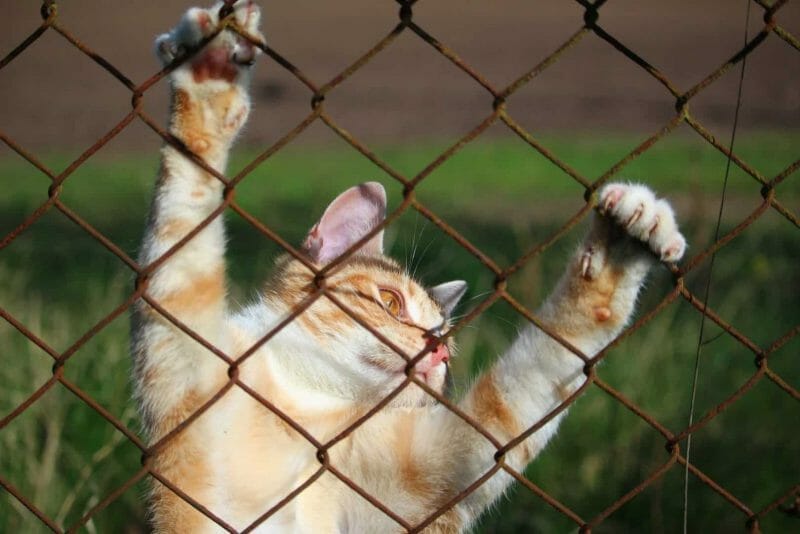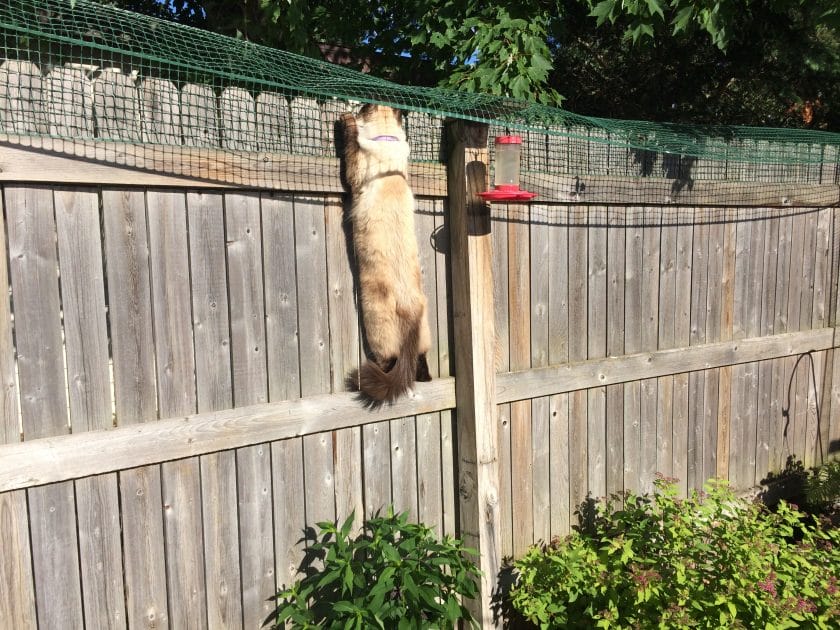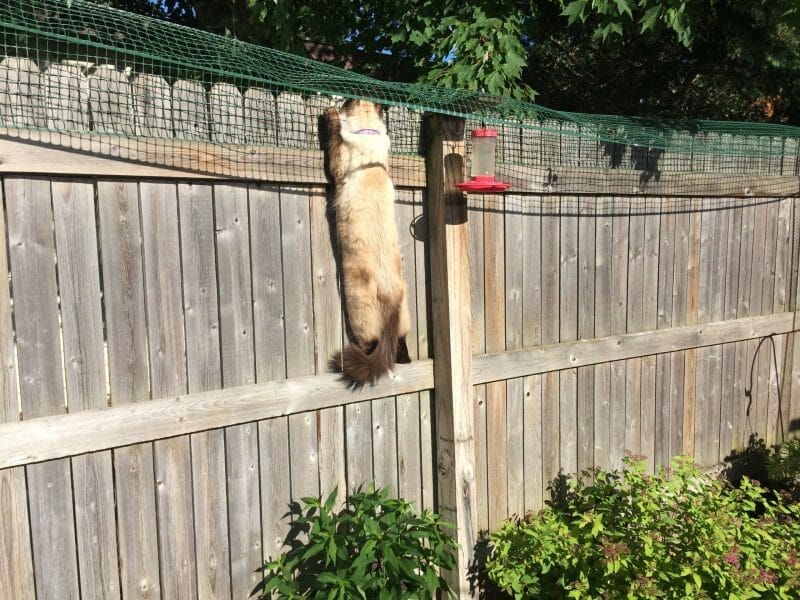If you’re a cat owner, you may be familiar with the constant worry of your feline friend escaping and wandering off.
Cats are curious creatures, and their natural instinct to explore can sometimes lead them to venture outside the safety of your property.
If you are tired of your cat constantly jumping over the fence and wandering off, don’t worry, we have the solution for you! With our expert tips and tricks, you can keep your cat from escaping and ensure their safety.
One of the most effective ways to prevent your cat from jumping the fence is by creating a secure and cat-proof backyard. Install a cat fence to keep your furry friend contained and give them a designated space to roam freely. Another strategy is to provide your cat with plenty of mental and physical stimulation. Engage them in interactive play sessions and provide climbing structures or perches to keep them entertained and less inclined to jump over the fence. Additionally, try using deterrents such as motion-activated sprinklers or noise devices to startle your cat away from the fence. This will create a negative association with jumping and discourage them from attempting to escape.
Read on to learn about the process in detail with the possible impacts of using each of these methods…

Installing a Cat-Proof Fence Extension
To ensure your cat’s safety and to give yourself peace of mind, installing a cat-proof fence extension is a great solution.
Why Install a Cat-Proof Fence Extension?
Installing a cat-proof fence extension provides numerous benefits for both you and your beloved pet. Here are a few reasons why you should consider this installation:
Preventing Escape:
Cats are excellent climbers and jumpers, and they can easily escape over standard fences. A cat-proof fence extension adds height and a barrier that makes it significantly more difficult for your cat to escape.
Protecting from Dangers:
The great outdoors can pose various dangers to cats, such as traffic, predatory animals, and exposure to diseases. A cat-proof fence extension keeps your cat safely contained within your yard, away from these potential threats.
Reducing Stress:
Knowing that your cat is secure within the boundaries of your property can help alleviate the stress and anxiety of constantly worrying about their safety. A cat-proof fence extension provides you with peace of mind.
Preserving Wildlife:
Cats are natural hunters, and when they roam freely, they can have a detrimental impact on local wildlife. By keeping your cat confined to your yard with a cat-proof fence extension, you’re helping to protect the environment.
Choosing the Right Cat-Proof Fence Extension
Before installing a cat-proof fence extension, it’s essential to select the right one that suits your needs and your cat’s abilities. Here are a few factors to consider:
Fence Type:
Determine the type of fence you currently have and ensure that the cat-proof extension is compatible with it. There are various options available, such as netting, angled extenders, or roller bars.
Height:
Measure the existing fence and choose an extension that adds enough height to prevent your cat from jumping over. Make sure the extension is tall enough to keep your cat safely contained.
Installation:
Consider how easy or complex the installation process is for the cat-proof fence extension. Some options may require professional installation, while others can be easily installed by homeowners.
Aesthetics:
If you’re concerned about the visual appeal of your fence, look for cat-proof extensions that blend seamlessly with the existing design of your fence.
Installation Process
There are a lot of ways you can use in your backyard depending on your budget and taste. However, I found this process the most economical and easy to do for any one with simple DIY tools and some chicken net. If you have a bit of time to spare and the rights tools and supplies, this could solve the problem for you like a charm.
If you are looking for a better-looking and more efficient solution, then you can try this heavy-duty solution-

Installing a cat-proof fence extension can be a DIY project with the right tools and materials. Here’s a general overview of the installation process:
- Measure the length of your fence and determine the number of cat-proof extensions required.
- Gather the necessary materials, such as the cat-proof fence extensions, brackets, screws, and other tools.
- Follow the manufacturer’s instructions for attaching the extensions to your existing fence. This may involve using brackets and screws to secure them firmly.
- Ensure that the extensions are installed at a sufficient height to prevent your cat from jumping over.
- Inspect the installation for any gaps or weak spots, making sure that the fence extension is secure and cat-proof.
Since the installation is pretty simple in almost all cases, I am not going into the details here. But if you want me to cover this in detail, let me know in the comment. If I find enough interest, I will create a separate content on this.

Using motion-activated deterrents to prevent cats from jumping fences
Motion-activated deterrents are devices that are designed to detect movement and trigger a response to discourage cats from jumping over fences. These deterrents use various mechanisms to startle cats and deter them from attempting to leap over boundaries. Here are some popular motion-activated deterrent options:
1. Ultrasonic deterrents
Ultrasonic deterrents emit high-frequency sound waves that are undetectable to humans but irritating to cats.
When a cat approaches the fence, the device detects its motion and emits a high-pitched noise, which acts as a deterrent. This type of deterrent is effective in repelling cats without causing any harm to them.
2. Water sprayers
Water sprayers are another effective motion-activated deterrent for preventing cats from jumping fences. These devices are connected to a water source and are triggered when a cat comes within range.
The water sprayer releases a burst of water, surprising the cat and discouraging it from attempting to jump over the fence. This method is particularly effective for outdoor areas with access to a water supply.
3. Air blasts
Air blast deterrents use compressed air to startle cats and deter them from jumping over fences.
When the device detects motion, it releases a burst of air towards the cat, creating a sudden gust of wind.
The unexpected blast of air surprises the cat and conditions it to associate the fence with an unpleasant experience, discouraging future attempts to jump over.
4. Motion-activated noise makers
Some motion-activated deterrents produce loud noises when triggered by a cat’s movement. These noise makers can be effective at deterring cats by creating an unappealing environment.
The sudden loud noise startles the cat and discourages it from attempting to jump over the fence. Noise makers can include devices that emit a high-pitched alarm sound or simulate the sound of a predator.
It’s important to note that the effectiveness of motion-activated deterrents may vary depending on the individual cat’s personality and determination to jump the fence. Some cats may become accustomed to the deterrent over time, necessitating the use of multiple deterrents or a combination of different types to maximize effectiveness.

Training methods for teaching cats to stay within the yard
In this section, we will explore some effective training techniques that can help you achieve this goal.
1. Leash Training:
One of the most reliable methods for teaching cats to stay within the yard is leash training. It involves attaching a leash to your cat’s harness or collar and taking them outside for supervised walks within the yard.
Start by allowing your cat to explore a small area while on the leash, gradually increasing the territory as they become more comfortable.
Use positive reinforcement, such as treats and praise, to reward them for staying within the designated area.
2. Boundary Training:
Boundary training involves teaching your cat to recognize and respect the boundaries of your yard.
To start, establish physical boundaries using visual markers like flags or small fences. Begin by walking your cat along the perimeter of the yard, gently guiding them away from the boundaries using verbal cues.
Reward them with treats and praise when they stay within the designated area. Consistency is key in boundary training, so repeat the process regularly until your cat understands the boundaries intuitively.
3. Positive Reinforcement:
Positive reinforcement is a powerful training technique that can be applied to almost any situation, including teaching cats to stay within the yard.
Whenever you notice your cat staying within the designated area, provide them with treats, petting, or verbal praise to reinforce the behavior.
Cats respond well to positive reinforcement, and they are more likely to repeat behaviors that have been rewarded.
4. Environmental Enrichment:
Cats are naturally curious and easily bored, which can lead to them seeking stimulation outside the yard. By enriching their environment within the yard, you can reduce their desire to explore beyond the boundaries.
Provide your cat with plenty of engaging toys, scratching posts, and climbing structures to keep them entertained and mentally stimulated. Consider creating a designated play area within the yard where your cat can engage in various activities and expend their energy.
Creating an Enclosed Outdoor Space for Cats to Prevent Fence Jumping
Creating an enclosed outdoor space specifically designed for cats can be a great solution to prevent fence jumping and keep your feline companion safe.
1. Assessing your space:
Before embarking on the project of creating an enclosed outdoor space for your cat, it’s essential to assess your available space and determine the best location for this purpose.
Consider the size of your yard, any existing structures, and the proximity to your house. Ideally, the space should be easily accessible and provide enough room for your cat to roam and play.
2. Choosing the right materials:
When building an outdoor enclosure for your cat, selecting the right materials is crucial.
Opt for sturdy materials that can withstand outdoor elements and ensure the safety of your cat.
Some popular choices include galvanized steel mesh or wire, chain link fencing, and reinforced netting.
Make sure the materials you choose are secure enough to prevent your cat from squeezing through or escaping.
3. Designing the layout:
Take some time to plan and design the layout of your cat enclosure, considering both functionality and aesthetics.
Incorporate different levels and vertical spaces for your cat to explore, such as platforms, ramps, shelves, and climbing trees.
Providing various hiding spots, scratching posts, and toys can also keep your cat entertained and mentally stimulated.
4. Securing the perimeter:
It’s essential to properly secure the perimeter of the cat enclosure to ensure your cat cannot jump or climb over the fence.
Install an overhang or roof to prevent your cat from scaling the walls. Additionally, bury the bottom of the fencing or netting several inches into the ground to deter any digging attempts.
Regularly inspect the enclosure for any potential escape routes and make necessary repairs or adjustments.
5. Creating a comfortable environment:
Apart from ensuring the safety of your cat, creating a comfortable environment within the enclosure is equally important.
Provide sheltered areas with cozy bedding, such as outdoor cat houses or insulated boxes, to protect your cat from harsh weather conditions. Place water bowls, feeding stations, and litter boxes in easily accessible locations.
Consider adding some plants or cat-friendly grass to mimic a natural outdoor environment.
6. Supervise and enrich:
While an enclosed outdoor space provides a safe environment for your cat to explore, it’s essential to supervise their time outside and ensure they are not exposed to any potential dangers.
Regularly inspect the enclosure for any signs of wear or damage, and perform routine maintenance to keep it in optimal condition. Additionally, regularly introduce new toys, interactive games, and puzzle feeders to provide mental stimulation for your cat.
Frequently Asked Questions
What can I put on my fence to keep cats away?
You can use a variety of deterrents to keep cats away from your fence. Some options include motion-activated sprinklers, commercial cat repellent sprays, or even homemade solutions like citrus peels or coffee grounds scattered along the fence line.
What material can cats not climb?
Cats are less likely to climb smooth and slippery materials like PVC piping, metal sheets, or even vinyl-clad fences, as they can’t get a good grip on these surfaces.
How do you train a cat to stay in a fence?
Training a cat to stay within a fence requires patience and consistency. Use positive reinforcement techniques, like treats and praise, to reward your cat for staying inside the fenced area. Gradually introduce them to the space and supervise their behavior until they learn the boundaries.
What smell do cats hate the most?
Cats generally dislike strong scents like citrus, mint, and eucalyptus. You can use these scents to deter them from certain areas or your fence.
Does vinegar keep cats away?
Yes, vinegar is one of the scents that cats often dislike. Mixing vinegar with water in a spray bottle and applying it to your fence or the surrounding area can help deter cats.
What smells cats can’t stand?
Besides vinegar, cats also tend to dislike the smell of coffee grounds, cayenne pepper, lavender oil, and rosemary.
What material do cats hate?
Cats typically dislike materials that are difficult for them to scratch or climb, such as aluminum foil, double-sided tape, or plastic spikes placed on the fence surface.
What is a cat’s favorite material?
Cats often enjoy materials like sisal rope, carpet, and rough-textured fabrics for scratching and climbing. Providing designated scratching posts made from these materials can keep them entertained and prevent them from trying to climb your fence.
Conclusion
Keeping your cat from jumping over the fence requires a combination of preventive measures and environmental modifications.
By understanding your cat’s behavior and providing adequate mental and physical stimulation, you can help reduce their desire to explore beyond the boundaries. Installing cat-proof fencing systems, using deterrents such as motion-activated sprinklers or ultrasonic devices, and providing vertical spaces like cat trees or shelves can effectively discourage fence jumping.
Additionally, regular training sessions and positive reinforcement can help reinforce boundaries and redirect your cat’s attention towards more appropriate areas for play and relaxation.
Remember, each cat is unique, and it may take some trial and error to find the right combination of strategies that work best for your furry friend.
With patience, consistency, and understanding, you can create a safe and secure environment for your cat while still allowing them to enjoy the outdoors.


